What is EMM? How Does It Work to Secure Corporate Data?
As the mobile workforce continues to rise, companies are saddled with the responsibility of providing their employees with devices to use. However, solutions exist to either allow employees to participate in a Bring Your Own Device (BYOD) policy. Services also allow companies to more effectively manage company and BYOD devices to navigate security concerns.
With the development of Apple Business Manager and Android Enterprise Work Profile to handle mobile app management, enterprise mobility management services are needed more than ever before.
In this guide, we’ll discuss what enterprise mobility management is and how companies can use EMM to secure their data and mitigate concerns that stem from allowing employees to use their own devices.
1What is Enterprise Mobility Management (EMM)?
So, what is EMM? EMM refers to a service of tools that allow for corporate mobility management of the data and content of mobile devices under company control. To explain enterprise mobility management more specifically, let’s break down EMM into each of its parts.

- First, ‘enterprise’ refers to businesses or companies, indicating that EMMs are for business use rather than personal use. EMM can be used by small to enterprise-level companies for work-related devices.
- Second, ‘mobility’ refers to the use of mobile devices, such as smartphones, tablets, and laptops. EMMs can also support rugged handheld devices intended for businesses.
- And third, ‘management’ refers to the need for companies to manage the content on company and BYOD devices for work. There are a variety of settings and systems that a company may need to manage depending on its niche. From device system settings, network selection and settings, applications downloaded and updates, data stored in the device, user access and identity, documentation, and email.
2How Does EMM Work?
Enterprise mobility management services combine many services within one platform to allow companies to access and make changes to company devices more easily on an organization-wide basis. Within an EMM, businesses will find solutions that are also offered separately, including MDM, MAM, MCM, and MIM features.
Companies can use EMM solutions to set up brand-new company-owned devices or allow employees to access company accounts, such as email or corporate apps. This is done by first logging into your chosen EMM console and entering account information.
In this section, we will break down each of these features of an EMM and explain how the systems can help companies manage their corporate and BYOD devices.
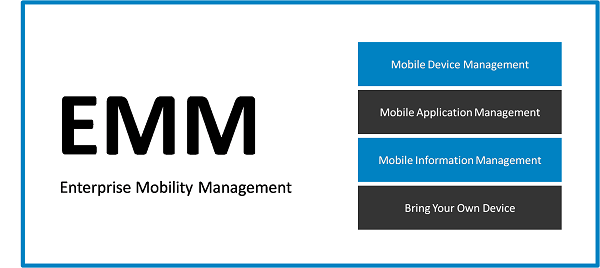
1. Mobile Device Management (MDM)
Mobile device management (MDM) features include enrollment, deployment, and policy settings. Through an MDM, devices become associated with user profiles to allow bulk access to applications and necessary company accounts.
Enterprise mobility policy can be adjusted through MDM features.
2. Mobile Application Management (MAM)
Mobile application management (MAM) features are geared toward setting up work profiles and managing the use and downloads of applications on an employee company or personal device.
Regular updates on corporate applications are also managed by the MAM aspect of an EMM, which helps to ensure the device stays secure. MAM settings can also help to change application settings on a device. These settings are especially helpful in situations where employees are using personal devices to access company accounts on applications.
3. Mobile Content Management (MCM)
On the other hand, mobile content management (MCM) focuses on settings related to device access and the encryption of company data that may be stored on the device. The MCM aspects allow employees to access work-related content without sacrificing key security and access requirements.
What is MCM Client Apps? How Does It Improve BYOD Security?
4. Mobile Identity Management
Finally, the mobile identity management (MIM) aspect of EMM addresses user access settings, including the implementation of two-factor authentication (2FA), and establishes password rules over devices and apps.
What's more: How does EMM enhance data security?
- Security by Design: Mobile OS has equipped with security features and is compliant with information security regulations. Android, as an example, its enterprise-level framework commitment to the GDPR. And those recommended devices and service providers follow the compliance of Android Enterprise.
- Container: App data is kept separately. And the containerization is used in BYOD also. In Android EMM, you can find work profile as an example of the application. Enterprise will have more managment options on corporate data.
- Password Policy: EMM providers are available to enfore password rules over the mobile devices, including complexity settings, lockout policy for failed login attempts, change password, etc.
- Remote Control: Using EMM, the IT admin can remotely screenlock and wipe all device data as well as the data of applications.
- App Permission Management: Not only controlling the emloyee's access of using mobile apps, but also the apps themselve. EMM solutions are able to decide what data can be collected by the mobile apps.
34 Use Cases of Enterprise Mobility Management
Any company can use EMM to manage the content of its mobile devices. However, there are certain use cases that serve as great examples of why EMM is a necessary service for companies to use. In this section, we’ll review four industries and how they can use enterprise mobility management to make their company run smoother, avoid security concerns, and prevent users from misusing devices.
1Healthcare
The healthcare industry is a highly secure industry due to federal regulations, such as HIPAA. Patient privacy is of the utmost importance to comply with the law. In the past, the healthcare industry relied on the secure storage of paper files to conform with these laws, but as the digital age changes the way patients and providers interact with one another, the use of mobile devices has become essential.
Healthcare organizations must ensure that the security policies of mobile devices are strictly adhered to to avoid data breaches that might reveal confidential patient information. To enforce these policies, healthcare companies can use EMM to regulate and standardize policies and settings used on company or BYOD Work Profile devices.

2Logistics
As a particularly widespread and time-sensitive industry, the logistics industry must manage a spread-out mobile workforce with strict deadlines. Driver devices must be able to be managed from across the country or even around the world during transport. These devices must be updated regularly and may need to be accessed for remote troubleshooting while drivers are delivering or picking up orders.
Accessing a widespread remote workforce is more easily done through an EMM because of unique features such as Remote Control which allows administrators to access the device fully remotely.
3Field Service
Field service organizations also face similar issues to the logistics industry. With a widespread workforce, IT administrators have little to no face-to-face time with employees to work on devices. Instead, devices must be shipped to new employees during onboarding or for BYOD, and new employees must download company applications and sign into company accounts through a personal device.
An EMM will help to simplify onboarding, allow for fully remote support, and sufficient monitoring of the data usage of devices.
4Education
In the education industry, companies and school districts are in the unique position of deploying devices for teacher and student use. Remote learning during the COVID-19 pandemic school shutdowns saw students taking home mobile devices, including laptops, in order to continue attending school if they did not have a computer at home.
The education industry will benefit from EMM features such as limiting device usage and enhancing device efficiency. Application restrictions are crucial, as well as implementing device access limitations.

4Benefits of Enterprise Mobility Management
There are many benefits to using enterprise mobility management to manage company devices and accounts. Among them are security, enforced updates, compliance, remote control, and user access.
Security
Increased security is one of the primary benefits of using EMM to manage employee accounts and devices. Conformance with security policies is one of the most effective ways of securing company data, and EMMs are a way that companies can mandate that mobile devices are all in compliance with updates, account sign-on procedures,
Updates
Additionally, keeping devices and applications regularly updated helps to avoid additional security concerns. Updates address major security concerns, as applications and devices regularly push updates to fix security concerns. When these updates don’t take place, breaches are more likely.
Compliance Policy
Establishing compliance policies for devices is easy through an EMM, which allows companies to define rules that ensure compliance. Then, companies can deny access to non-compliant devices, further protecting themselves from security and data concerns.
Remote Control
EMM also allows companies to access devices via Remote Control, which allows them to interact with devices remotely. Remote Control of devices alone has numerous benefits, including easier secure remote troubleshooting.
User Access
Setting up user profiles, two-factor authentication, and single sign-on are key methods companies can use to secure their data. These settings ensure that the employee is accessing company data, not someone else, if the mobile device were to fall into the wrong hands.
5Trends of EMM in 2023
Technology changes very rapidly, which means that EMM must also follow the trends. In 2023, EMM platforms are addressing major industry changes such as increased device needs, Apple Enterprise, the 5G rollout, and improvements in artificial intelligence.
The 5G network expansion necessitates the use of newer devices to access the network, which means that companies may be investing in newer devices that will need to be managed. EMMs have begun to adjust their capabilities to prepare for an increase in devices that use 5G as their cellular data network.
Another work trend in 2023 that goes hand-in-hand with EMM is that of saving time and automating repetitive tasks. EMM services allow technicians and administrators to access devices in bulk and enforce updates and policy changes to multiple devices at once.
AirDroid Business - Android Enterprise Mobility Management Solution
AirDroid Business helps to manage and control the Android mobile workforce. This enables real-time monitoring of Android devices with intelligent alerts, and remote troubleshooting.
It also provides a secure and centralized platform to enfore mobility policy, manage apps from Managed Google Play, single & multi-apps kiosk mode, kiosk browser, etc.
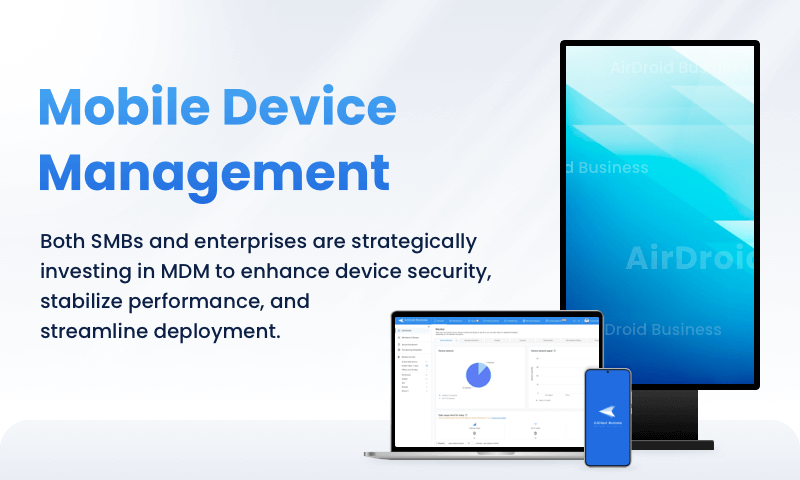
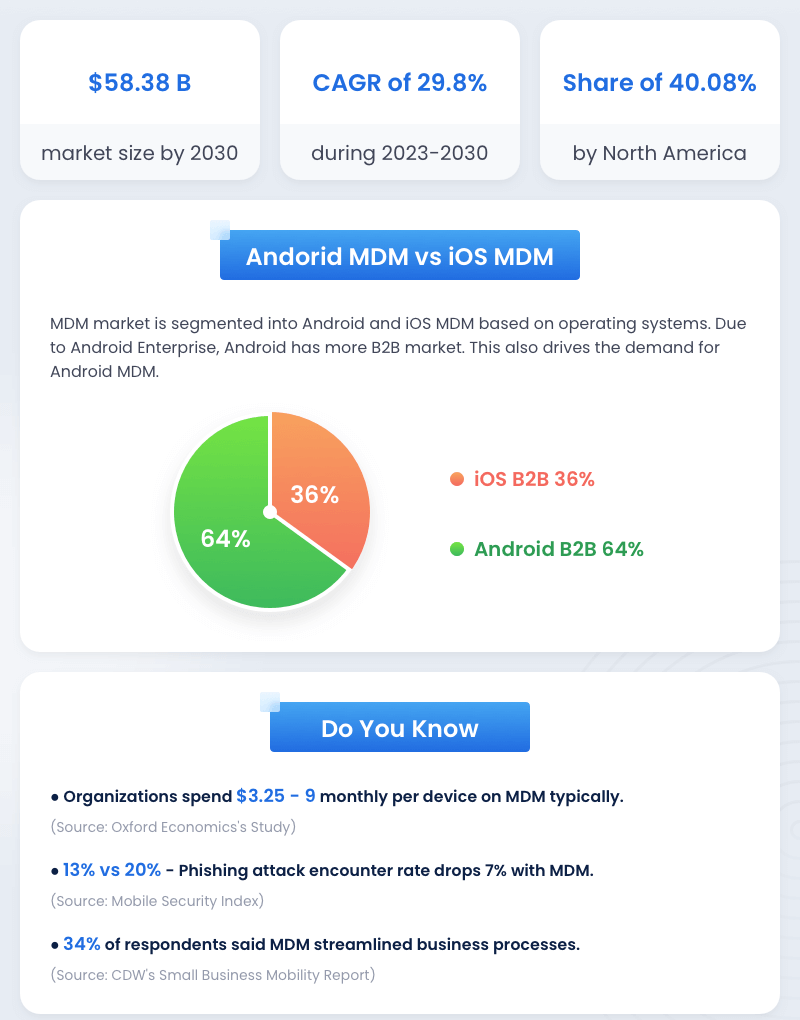
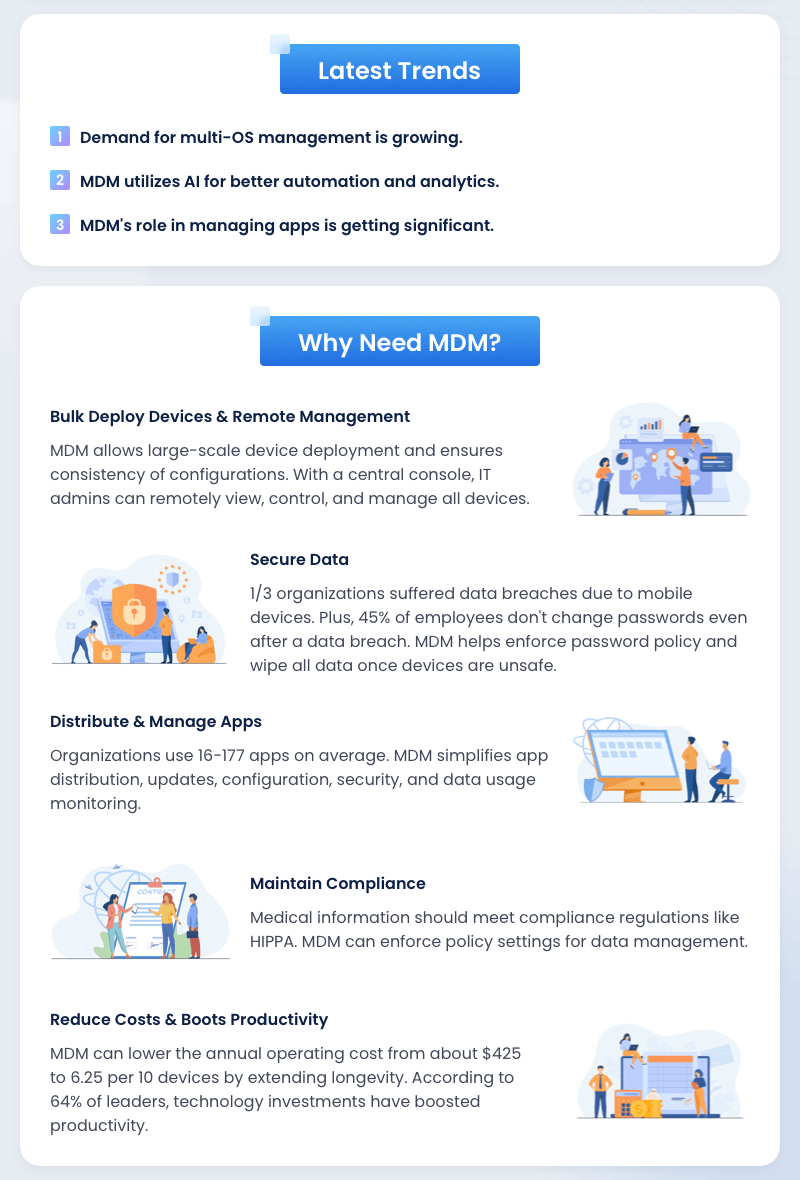
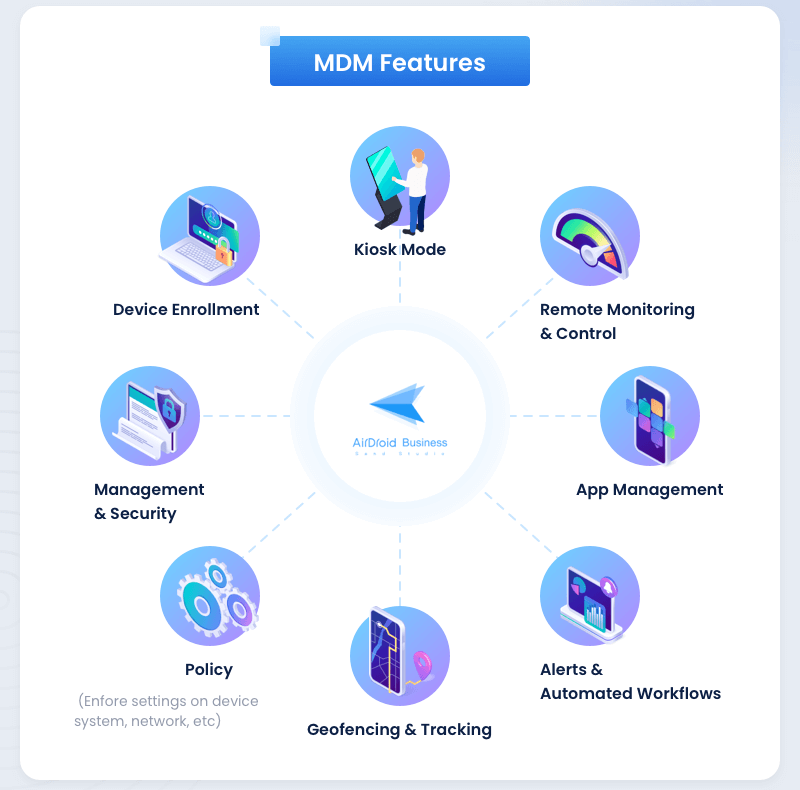
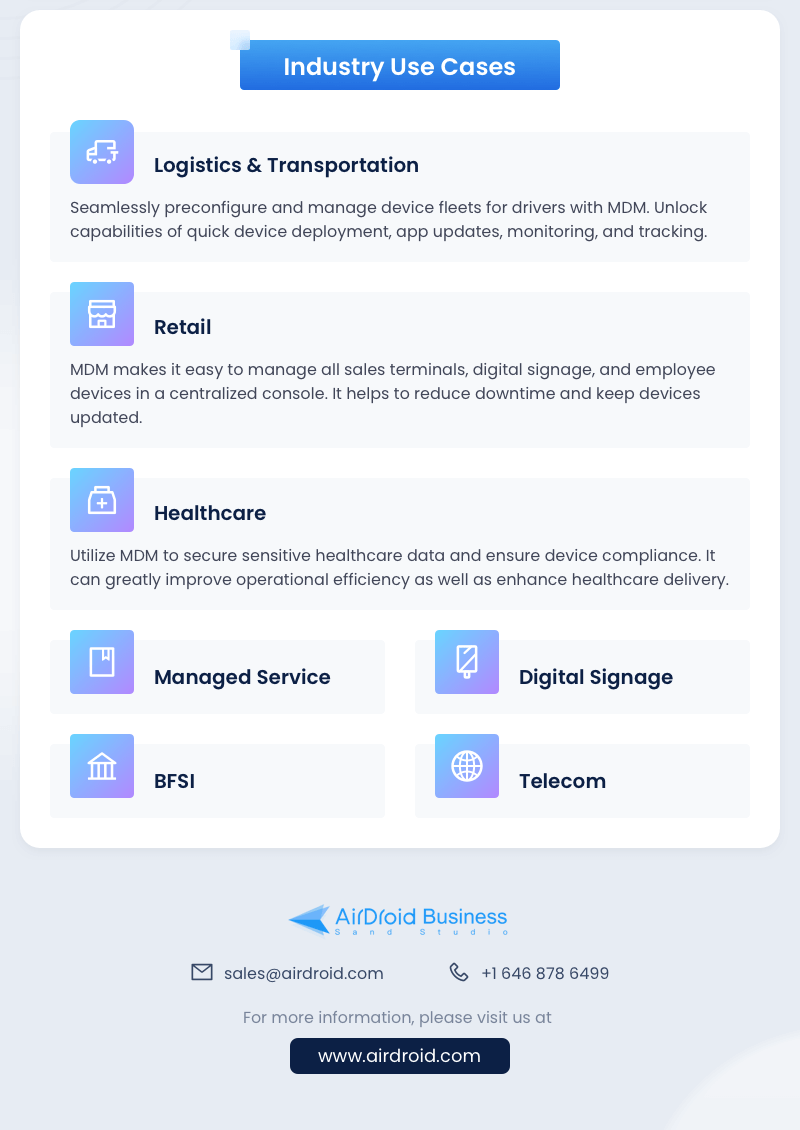






Leave a Reply.